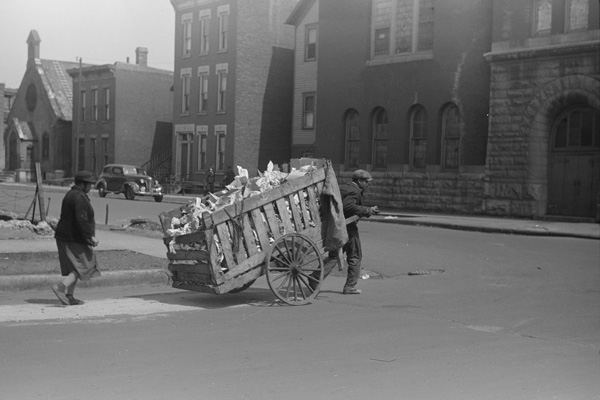
Photo: Edwin Rosskam/Library of Congress
Man and woman collecting paper and trash for sale, Chicago, 1941
Not long ago I wrote about how Chicago fares poorly, compared to other metro areas and much of America, when it comes to income mobility. The catalyst was research by Harvard economist Raj Chetty and his co-authors, who produced a remarkable map of the country's economic mobility:

The worst of the biggest 50 metros are Atlanta (four percent odds of reaching the top fifth income bracket from the bottom fifth, almost one-third the chances of top metros) and Charlotte (4.3 percent). After that it's the Rust Belt: Indianapolis (4.8), Detroit (5.1), Columbus (5.1), and Cleveland (5.2).
But the most obvious patterns are western areas with reservations, and the South. The South is blood-red, almost uniformly, but there are variations within that. In particular, there's a belt of the lowest income mobility beginning in piedmont North Carolina and running southwest to the Mississippi Delta through South Carolina, Georgia, Alabama, and iinto Arkansas and Louisiana.
At Bloomberg View, Cass Sunstein—ex-U. of C. prof and White House advisor, current Harvard Law prof, and jack-of-all-trades public intellectual—takes up the question of why economic mobility is worse in the South:
The good news is that the U.S. as a whole isn’t suffering from especially low levels of intergenerational mobility. The problem is fairly localized, and we know where to find it. But two fundamental questions remain: Why, exactly, is intergenerational mobility high in some regions and low in others? And where it is low, what can be done to increase it?
Sunstein follows Chetty in looking at policies like EITC and progressive income taxes, and there's correlative evidence to suggest it. But other correlative evidence from history follows the region of the lowest income mobility in the South. And it looks an awful lot like this:
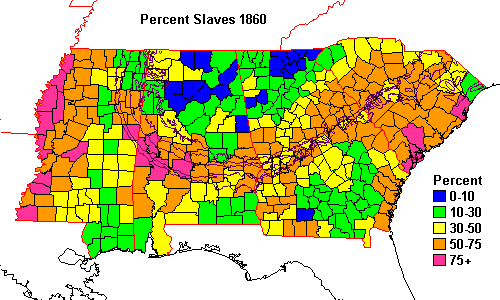
That's from a fascinating post on Deep Sea News about the cotton belt and American elections. Why is it in Deep Sea News? Because the location of seas during the Cretaceous created extraordinarly rich soils—the Black Belt—which in turn led to the cotton belt, which was farmed by slaves. The sub-regional percentage of slaves in 1860 lines up with 1859 cotton production, which in turn lines up eerily well with income mobility in the late 20th-early 21st century. The New York Times map, with a different gradient, makes the point even more clearly:
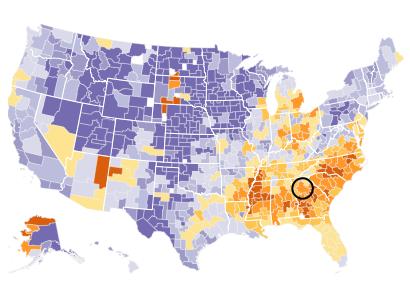
It's interactive and well worth taking a tour of (if you really go deep into the data, you'll find that the lowest income mobility figures tend to coincide with areas of high Native American population in the west). But the strongest continuity is with the cotton belt.
After the Civil War, slavery was replaced by tenant farming and sharecropping, which followed virtually identical patterns.
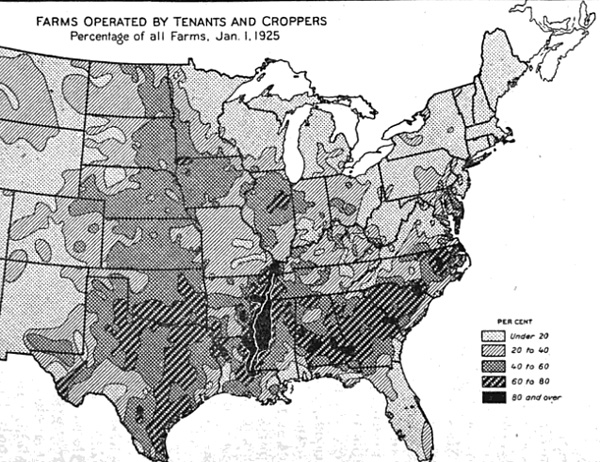
Interestingly, the isolated region of concentrated tenant and sharecropping farms in central Illinois in 1925 lines up with the region of decreased economic mobility today.
What does this have to do with Chicago? A couple things. First, the Great Migration's route to Chicago ran through the part of the South most devastated first by slavery and then by the near-feudal system of tenant and sharecropper farming: central and western Mississippi, because of the Illinois Central line, which ran along the eastern border of the most intense concentration of tenant/sharecropper farming in America.
And that system continued well into the 20th century, as Nicholas Lehmann found when researching "The Origins of the Underclass," which focuses on the connections between Chicago and Canton, Mississippi:
Through the mid-twentieth century Madison County was settled into a system of segregation and sharecropping. I found no real disagreement between blacks and whites about the particulars: All but a handful of blacks, fewer than a hundred, were denied the right to vote, by means of a poll tax and a "literacy test," in which the registrar of voters would pick at random a section of the Mississippi constitution and ask black would-be voters to read it aloud and then deliver an interpretation. There were separate black and white schools in Canton, and in the countryside blacks went to one-room schoolhouses with no new books, heat, electricity, or running water. In April and May, and then again in September and October, many blacks, especially in the country, had to leave school to work in the cotton fields, so even a decent junior high school education was a great rarity among rural blacks.
Migrants left places like Canton—which had a stop on the Illinois Central—to escape Jim Crow and improve their economic lot. Which they did, but not to the degree of other northern immigrants, as Isabel Wilkerson writes in The Warmth of Other Suns (the current One Book, One Chicago selection):
Blacks, though native born, were arriving as the poorest people from the poorest section of the country with the least access to the worst education. Over the decades of the Migration, they came with every disadvantage and found themselves competing not only with newcomers like themselves but with second- and third-generation European immigrants already established in apprenticeships and factory jobs that were closed off to black migrants, the immigrants and their children permitted into the very trade unions that prohibited black citizens from joining.
Because they were largely excluded from well-paying positions in even unskilled occupations and were concentrated in servant work and other undesirable jobs, blacks were the lowest paid of all the recent arrivals. In 1950, blacks in the North and West made a median annual income of $1,628, compared to Italian immigrants, who made $2,295, Czechs, who made $2,339, Poles, who made $2,419, and Russians, who made $2,717.
Migrants to the North did improve their real wages, as Seth Sanders documents in "The Great Migration and African-American Mortality": "Black men in Mississippi in 1960 were earning $14,765 [in 2010 dollars] annually while migrants to the north were earning nearly $28,687." But this was only marginally more than migrants within the former Confederacy made: "What is of note is that migrants within the south earn $28,286 nearly the same level of earnings as migrants to the north." Sanders also found that migration did not improve mortality rates—perhaps because of the persistent effects of early-life poverty, perhaps because of increased housing costs in the North.
Sanders explains that one reason migrants made so much more money were higher levels of education, as a lack of resources and knowledge hindered migration. "One myth they had to overcome," Wilkerson writes, "was that they were bedraggled hayseeds just off the plantation." (White southerners, from the smaller migration out of Appalachia, encountered virtually identical stereotypes in Chicago.) In the later periods of the Great Migration, migrant Southern blacks had not just more education than those who stayed behind, they had more than Northern whites as well:
Against nearly every assumption about the Migration, the 1965 census found that the migrants of the 1950s—particularly those who came from towns and cities… had more education than even the northern white population they joined. The percentage of postwar black migrants who had graduated from high school was as high or higher than that of native whites in New York, Cleveland, Philadelphia, and St. Louis and close to the percentage of whites in Chicago.
Which leads us back to the staggering income immobility in the cotton belt. Slavery and sharecropping drove better-educated blacks out of the South, particularly from its poorest areas, leaving concentrated poverty behind and setting a devastated region back further still.
The persistence of slavery and sharecropping as economic models burdened the South for much of the 20th century. Decades after the Civil War, it was worse in some ways than the decades immediately following the War:
The post-bellum South was not, as some historians have termed it, a developing bourgeois society; in many ways it was not developing at all. Between the Civil War and World War II, the economies of the South and North were undergoing what [Gavin] Wright says was a divergence at a basic level. The gap between Southern and Northern wages was greater in the 20's and 30's than it had been at any time since the Civil War. The South's stagnation, in Mr. Wright's view, was caused by the low wages paid by planters and industrialists; as a result, they had little incentive to mechanize or innovate.
Innovation was snuffed out at levels much lower than industry, according to Wright: "the planters and employers who dominated regional politics were well aware that education greatly increased the probability that a young person would leave both the home county and ultimately the entire region."
The South actively pushed against industrialization. The results can be seen in a map that the Atlantic's Alexis Madrigal found of electricity usage in 1921, before the New Deal essentially forced modernization on the South: "In essence, the entire south used relatively less electricity than the rest of the country." Some Southern states less than others.
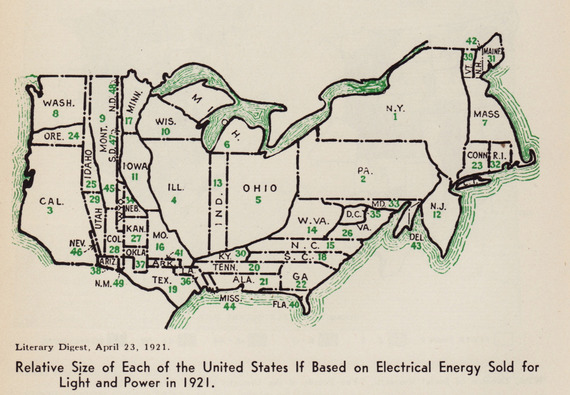
Fear of education retarded technological progress in the South while continuing to depress wages. Mississippi got the worst of it (from Wright):
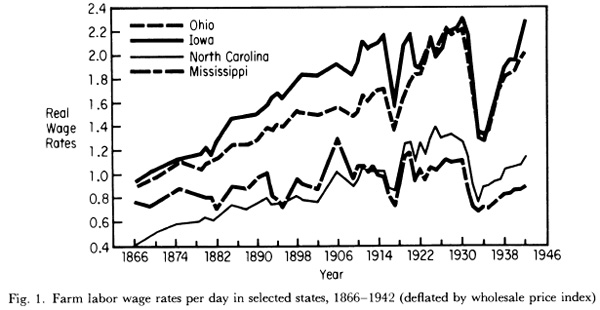
As Wright points out, "both the absolute and relative differentials were higher in the 1920s than at any time since the Civil War."
The politics and culture of the South sapped the productivity and promise of its citizens, on a regional level and as a whole—for blacks much more than whites, but certainly for both; during the centuries of slavery, but also in the century afterwards. Sunstein may well be right that current laws inhibit economic mobility in the South, but centuries of prior law continue to drag on its people—while pulling on the strings of history that run north up the Mississippi River and the Illinois Central line.


